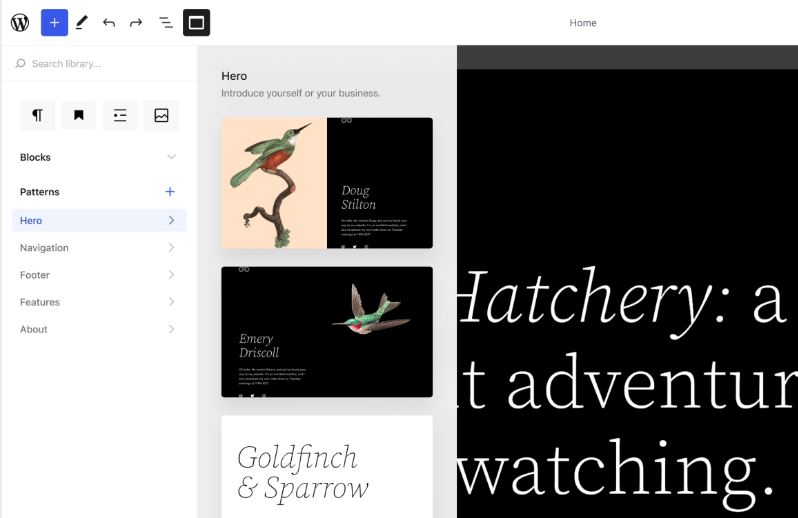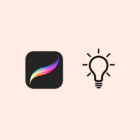Gutenberg lead architect Matías Ventura has identified refinements to experiences introduced in 5.9 and 6.0 as the main goal for the upcoming 6.1 release. He published the roadmap for 6.1 ahead of the closing session at WordCamp Europe in Porto, where he was scheduled to join Matt Mullenweg and Josepha Haden Chomphosy for a demo. Ventura wasn’t able to make it but he tweeted a thread with video demos of some exciting interface updates that Gutenberg contributors are working on.
One of the main thrusts is making site navigation a smoother experience through a new “browse mode” that will allow site editors to zoom in and out while working.
Patterns are another major focus that Ventura has identified as “a central piece of the creative experience.” Contributors are working on making it easier to build with patterns, with plans to improve the discovery and insertion process. WordPress 6.1 will bring better support for pattern usage in custom post types, block types, and a more intuitive experience locking patterns and managing saved patterns.

 image credit: WordPress 6.1 Roadmap
image credit: WordPress 6.1 Roadmap
Contributors are also exploring a new aerial view and other ideas for making it easier to interact with patterns as sections of a page, as Ventura demonstrated in his thread.
Patterns were a big focus at the conference in Porto and with 6.1 we’ll be trying ti elevate them further. A new aerial view is being explored to allow focusing on the top level sections of a page or template. pic.twitter.com/7JSeQQANt7
— Matías Ventura (@matias_ventura) June 8, 2022
Ventura said another goal for WordPress 6.1 is to improve the global styles interface with better support for restrictions, privileges, and curated presets. Design tools will also be updated to support responsive typography and allow managing webfonts.
“The tune of the release will be to refine the experiences introduced in 5.9 and 6.0, weave the various flows into more coherent and fulfilling experiences for users, maintainers, and extenders, and close some gaps in functionality as we start to look towards Phase 3 of the Gutenberg roadmap,” Ventura said.
Beyond WordPress 6.1: Collaboration Phase 3 Will Precede Multilingual Phase 4 to Establish Core Architecture
Matt Mullenweg and Josepha Haden Chomphosy addressed several questions regarding WordPress’ long term roadmap during their Q&A session at WordCamp Europe. (The video from the livestream is embedded below.)
WordPress core contributors plan to close out the Customization phase before beginning on the Collaboration phase in 2023. During the Q&A session, one of the polyglot contributors asked why WordPress is waiting until Phase 4 to begin working on multilingual features in core.
“Part of the reason we don’t want to set data now and then work on the feature later is that we have learned every time that it’s hard to create the architecture for something without creating the user experience,” Mullwenweg said. “When we try to do one without the other, for example with the REST API we got into the REST API before we were fully using it ourselves. As we started to do first-party usage of the REST API with Gutenberg, we found a bunch of gaps. I would feel particularly bad if those gaps meant plugins had been building on the wrong architecture for a few years.”
Mullenweg also explained why he believes it’s important to prioritize Phase 3, which he referred to as “workflow,” before the multilingual features:
Phase 3 is Workflow. This is basically where we’re going to take real-time co-editing into WordPress, much like Google docs or something else. When you log in to edit a page or your sites or a template or something, if someone else is in there at the same time, you’ll be able to see them moving around. Of course, we want to make sure we have version control built in like we do for posts and pages, into as many parts of WP as possible, so if someone makes a mistake or an edit to the site, you will be able to roll it back easily, which I think is really key for giving people confidence.
He emphasized the importance of establishing the collaboration architecture before introducing multilingual support into core.
“I think that the workflows around multilingual are important,” Mullenweg said. “So where is the content being canonically created, how do changes flow from one language to another, maybe even bi-directionally, depending on the people editing the site, and how that affects the rest of the templates – things that are outside the post and page content.”
He also noted the many third-party multilingual solutions that already exist will have a transition period as core integrates these features.
“I expect that much like has happened with page builders, once there’s something in core, they will either have a data migration path or integrate with whatever foundation we put into core,” Mullenweg said. “But I would like to set expectations that it’s probably more of a 2024 or 2025 initiative for WordPress. And we want to get these other phases done really well first. Why do we have to go in order? We can only do so much at once.”
When the person who had asked the question pressed for a reason why a contingency work group could not begin now, Mullenweg encouraged any eager contributors to put their work into a plugin. He referenced Gutenberg, which began as a plugin and was tested for years before bringing it into core.
I would say when we look at phase 4, the first thing we’re going to look at is how all the plugins are doing it. Perhaps one of those plugins could even become the basis for what comes into core. It’s OK if the plugins take different architectural approaches, because we want to see pluses and minuses of those. Remember people use WordPress with millions and millions of posts and pages, sometimes tens of millions. We want this to scale, we want this to be performant, we want it to be accessible. Take all the things people know and trust about WordPress. and bring it to this functionality.
Mullenweg said he thinks multilingual is “probably going to be one of the most complex things we bring into core, even more so than blocks.” The reason behind this is because blocks took what WordPress did before and gave it a new interface on top of HTML.
“Multilingual is taking every single thing inside of WordPress – tags, categories, pages, templates, and making it multi-factorial so it’s like a factorial amount of complexity on top of what right now is more of a one-to-one relationship,” he said. “If you have some ideas for how to do it, get involved with one of the existing plugins or start your own.”





